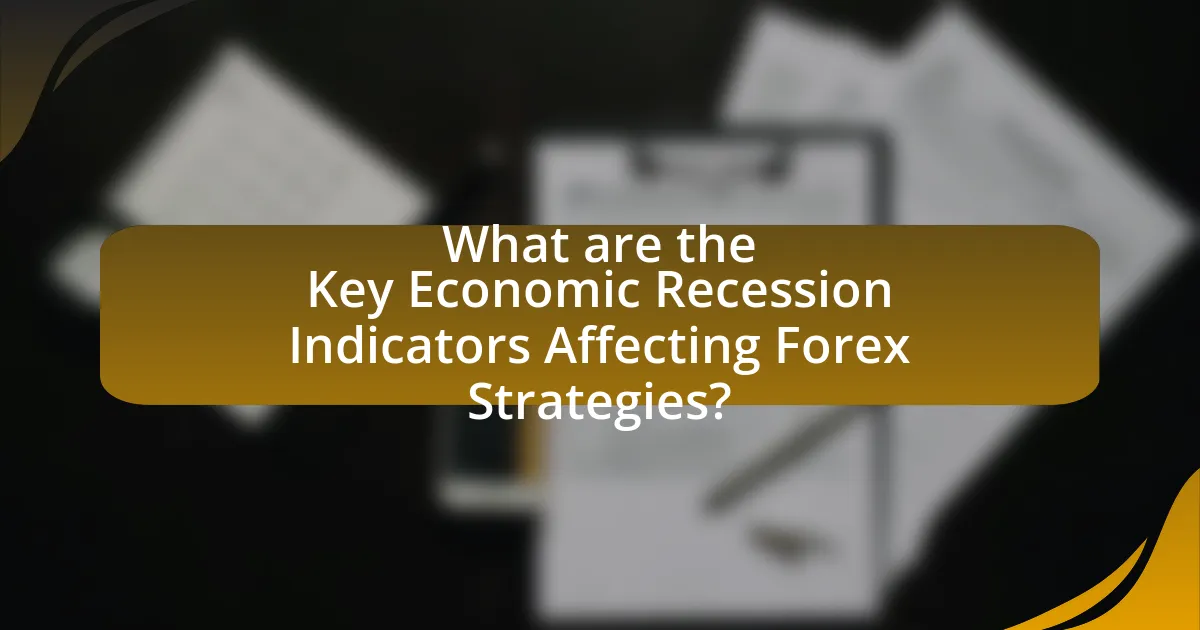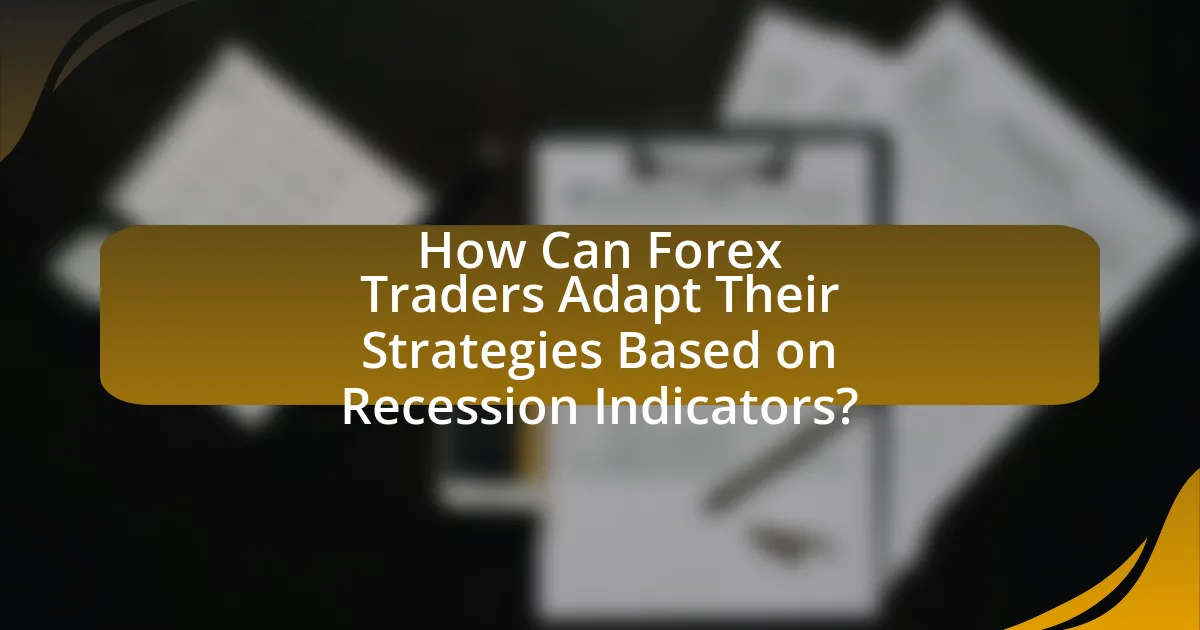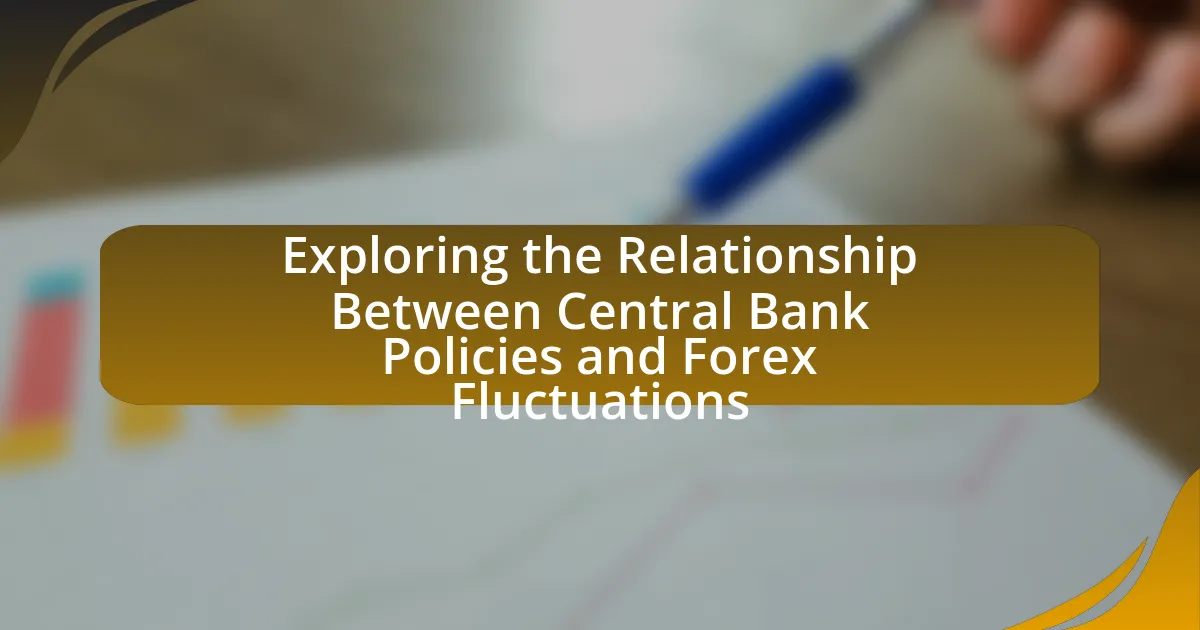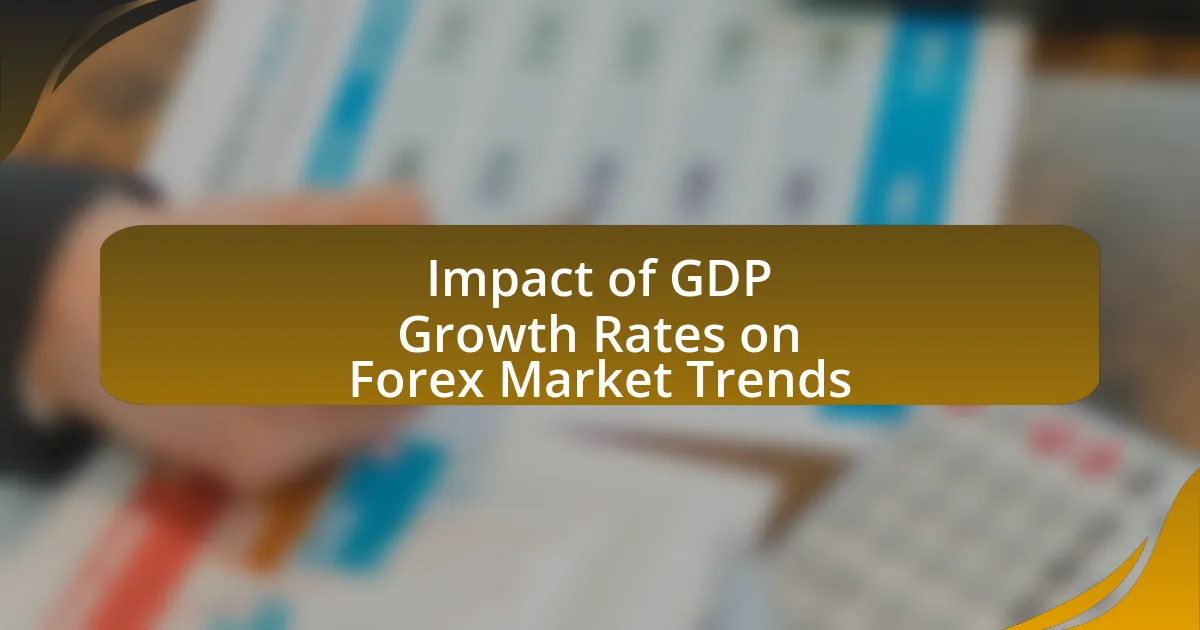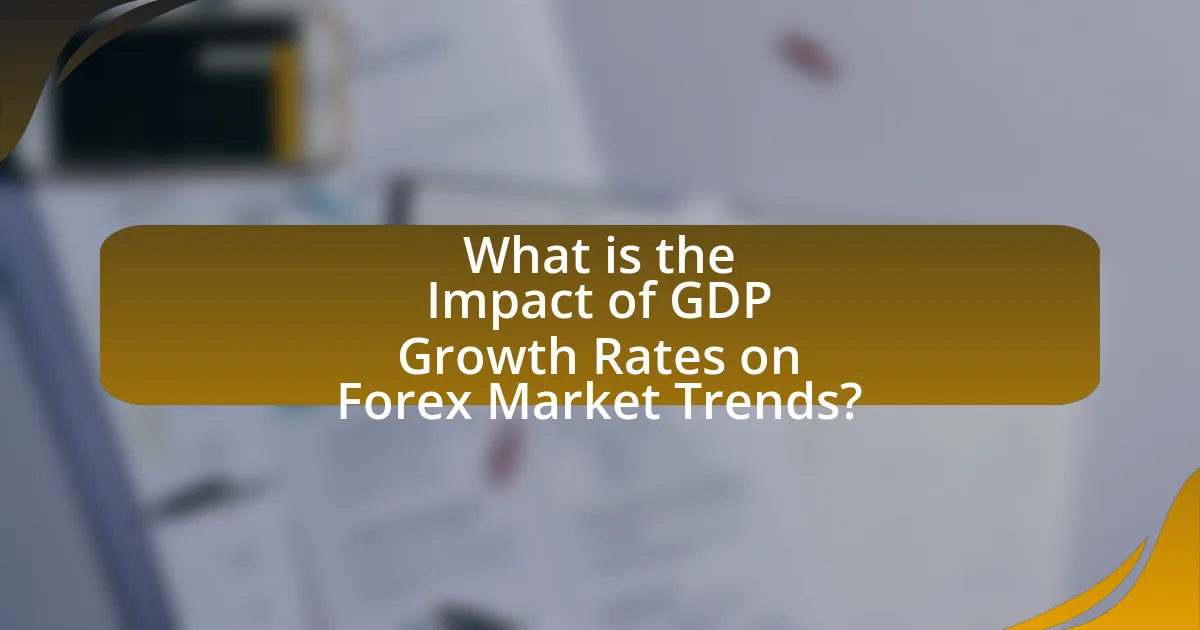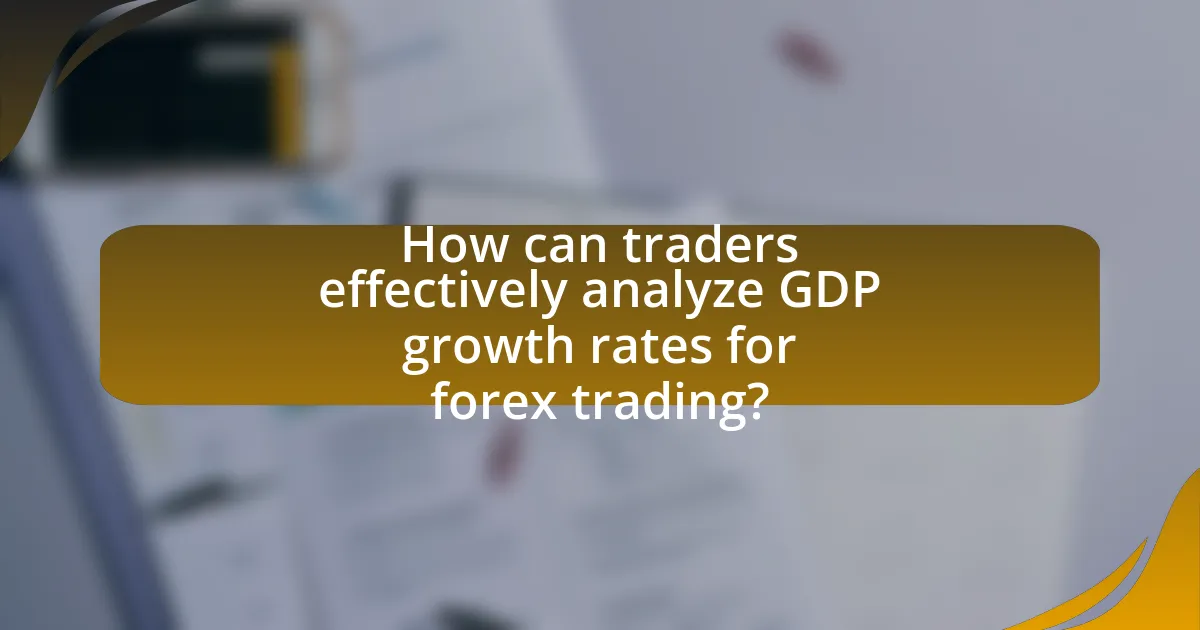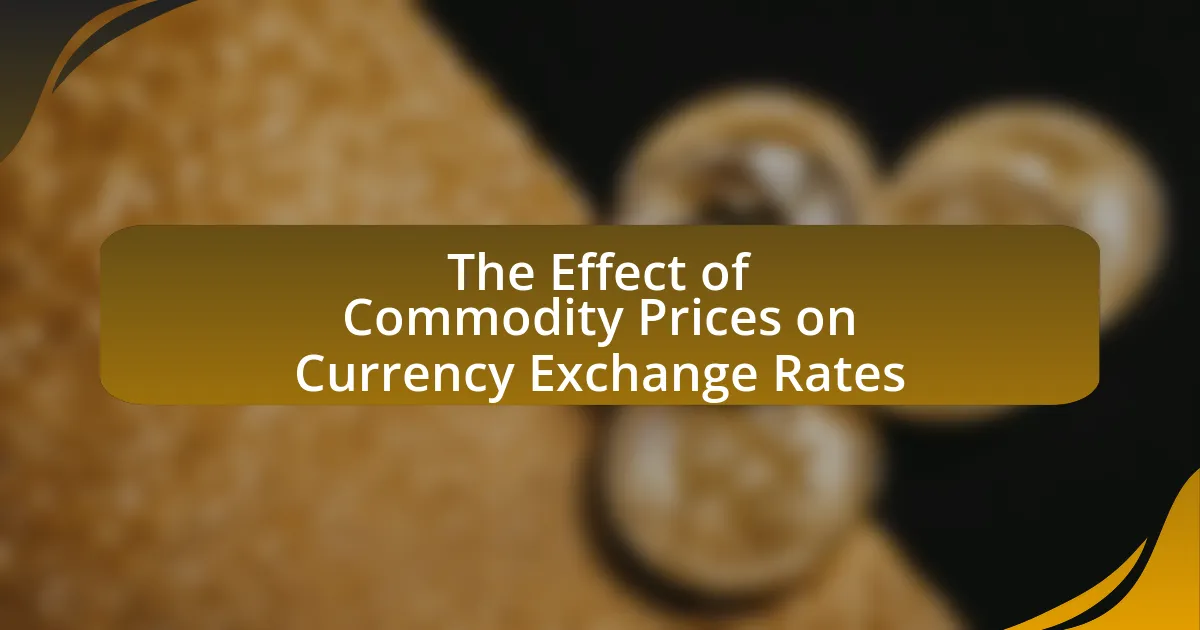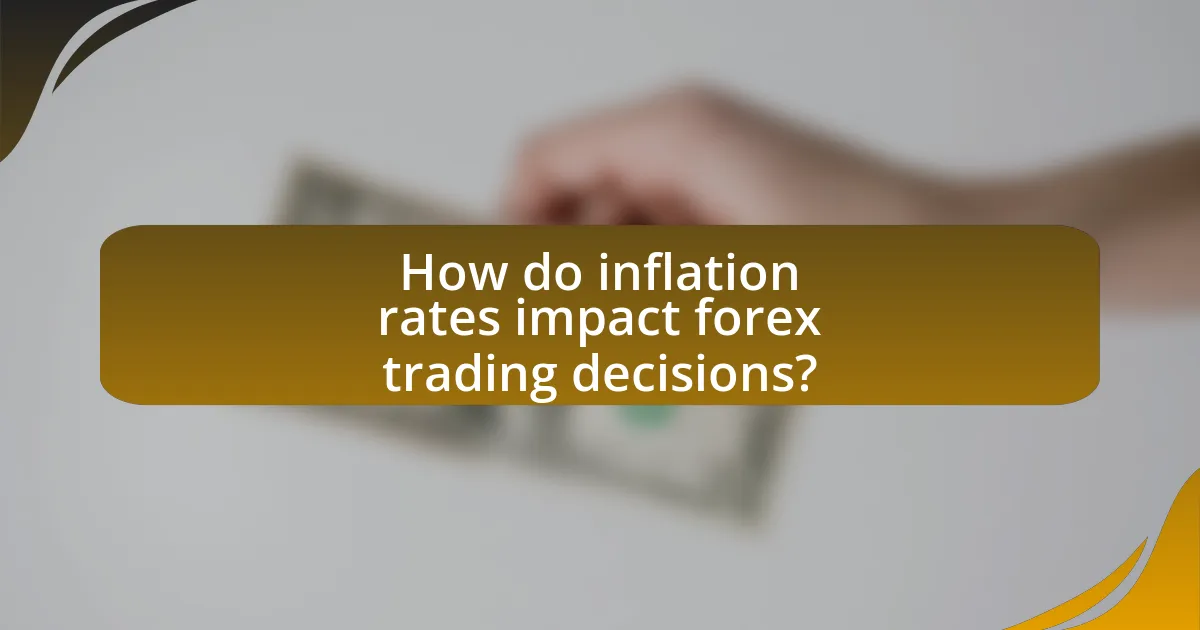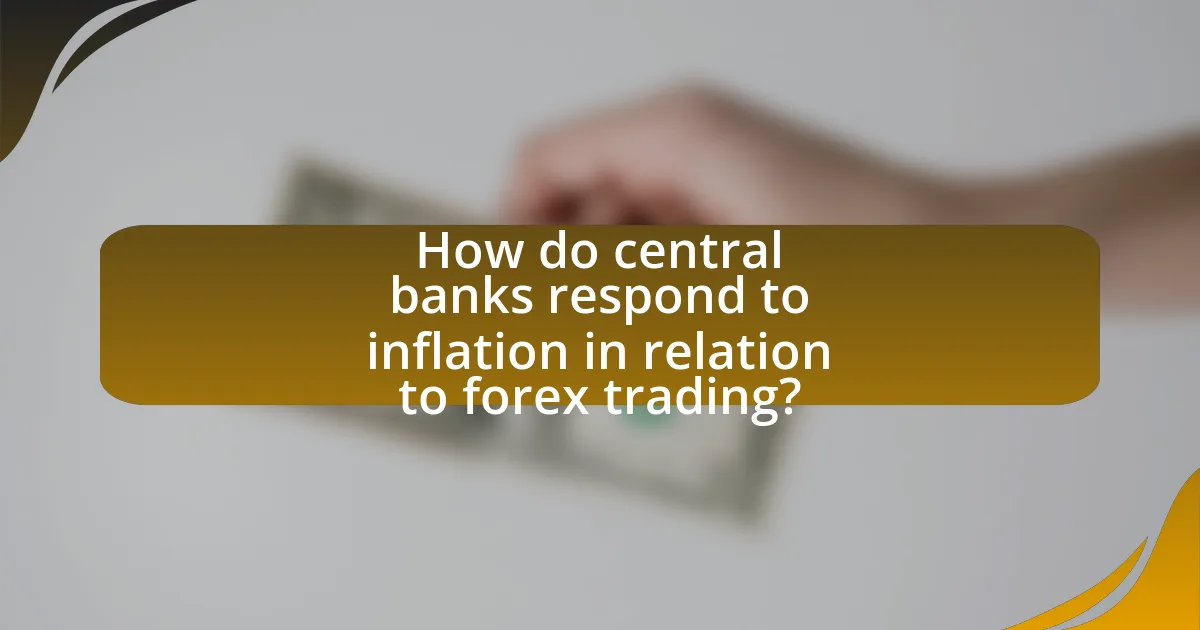Economic recovery indicators are essential statistical measures that reflect the health and growth of an economy, significantly influencing Forex trading. Key indicators such as GDP growth rates, unemployment rates, and consumer spending provide insights into currency strength and market trends. This article analyzes how these indicators impact Forex trading opportunities, detailing their role in assessing economic health and guiding traders’ decisions. It also explores the relationship between inflation, currency values, and the best practices for incorporating these indicators into trading strategies, emphasizing the importance of a systematic approach to enhance trading outcomes.

What are Economic Recovery Indicators and Their Importance in Forex Trading?
Economic recovery indicators are statistical measures that reflect the health and growth of an economy, such as GDP growth rates, unemployment rates, and consumer spending. These indicators are crucial in Forex trading as they provide insights into the economic conditions of a country, influencing currency strength and investor sentiment. For instance, a rising GDP typically signals economic expansion, leading to currency appreciation, while high unemployment may indicate economic distress, resulting in currency depreciation. Traders utilize these indicators to make informed decisions, predicting currency movements based on economic trends and data releases.
How do Economic Recovery Indicators influence Forex market trends?
Economic recovery indicators significantly influence Forex market trends by affecting currency valuations based on perceived economic health. For instance, positive indicators such as rising GDP, decreasing unemployment rates, and increasing consumer spending typically lead to a stronger currency, as traders anticipate higher interest rates and economic stability. Conversely, negative indicators can weaken a currency, as they suggest economic distress and potential monetary easing. Historical data shows that during the recovery phase following the 2008 financial crisis, currencies of countries with robust recovery indicators, like the United States, appreciated against those with weaker economic signals, such as the Eurozone. This correlation demonstrates how traders react to economic data releases, adjusting their positions based on the anticipated impact on currency strength.
What specific indicators are considered key for economic recovery?
Key indicators for economic recovery include GDP growth, unemployment rates, consumer spending, and business investment. GDP growth reflects the overall economic performance, with a rise indicating recovery. Unemployment rates provide insight into labor market health; a decrease suggests more job opportunities and economic stability. Consumer spending is crucial as it drives demand; increased spending typically signals confidence in the economy. Business investment indicates future growth potential; higher investment levels often correlate with economic expansion. These indicators are widely recognized in economic analysis and are essential for assessing recovery trends.
How do these indicators reflect the overall economic health?
Economic indicators reflect overall economic health by providing measurable data that indicates the performance and stability of an economy. For instance, metrics such as GDP growth rate, unemployment rate, and inflation rate serve as benchmarks for assessing economic activity. A rising GDP indicates economic expansion, while a declining unemployment rate suggests a robust job market, both of which signal positive economic health. Conversely, high inflation can erode purchasing power, indicating potential economic instability. Historical data supports this; for example, during the recovery from the 2008 financial crisis, improvements in these indicators correlated with increased consumer confidence and spending, further reinforcing the economy’s recovery trajectory.
Why should Forex traders pay attention to Economic Recovery Indicators?
Forex traders should pay attention to Economic Recovery Indicators because these metrics provide critical insights into the health of an economy, influencing currency values. Economic Recovery Indicators, such as GDP growth rates, unemployment figures, and consumer spending, signal the potential for currency appreciation or depreciation. For instance, a rising GDP typically correlates with a strengthening currency, as seen in the U.S. dollar’s performance following positive economic reports. Monitoring these indicators allows traders to make informed decisions, capitalize on market movements, and manage risks effectively.
What potential trading opportunities arise from these indicators?
Economic recovery indicators present trading opportunities by signaling shifts in currency strength and market sentiment. For instance, a rise in GDP growth rates typically leads to an appreciation of the associated currency, as it reflects a strengthening economy. Similarly, improvements in employment figures can boost consumer confidence, further enhancing currency value. Historical data shows that during periods of economic recovery, currencies like the US dollar and euro often experience increased volatility, creating opportunities for traders to capitalize on price movements. Additionally, central bank policies influenced by these indicators can lead to interest rate changes, which directly affect forex trading strategies.
How can traders use these indicators to make informed decisions?
Traders can use economic recovery indicators to make informed decisions by analyzing data such as GDP growth rates, unemployment figures, and consumer spending trends. These indicators provide insights into the overall health of an economy, allowing traders to anticipate currency movements. For instance, a rising GDP typically signals economic strength, which can lead to currency appreciation. Historical data shows that during periods of economic recovery, currencies of countries with strong growth often outperform those with weaker economic indicators. By integrating these indicators into their trading strategies, traders can better predict market trends and adjust their positions accordingly.
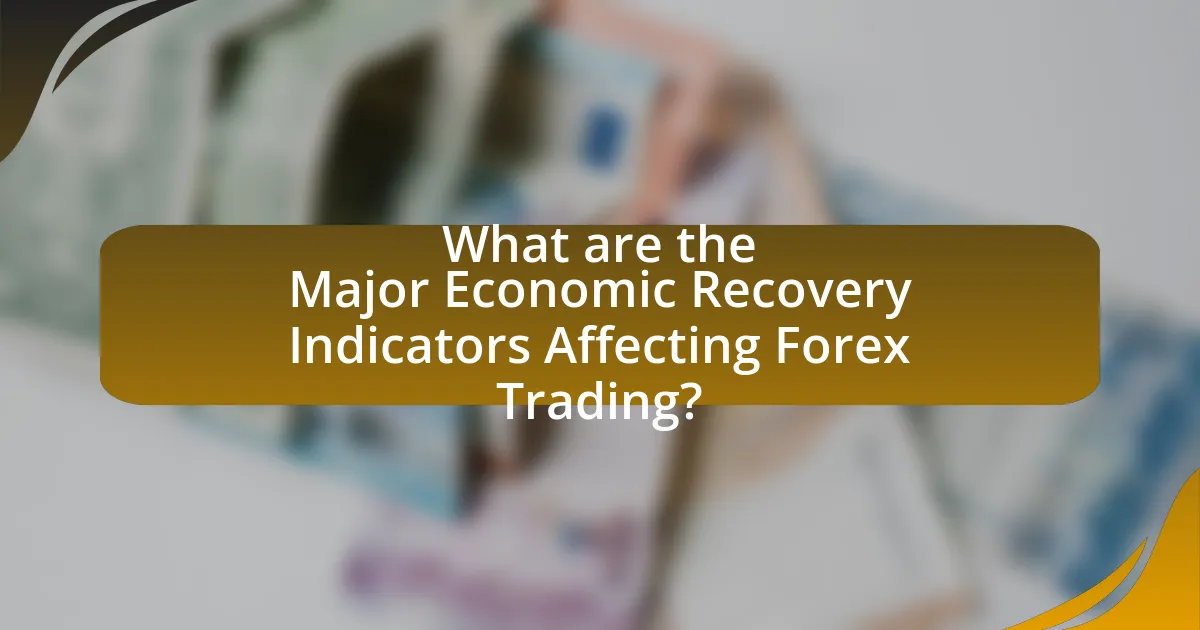
What are the Major Economic Recovery Indicators Affecting Forex Trading?
The major economic recovery indicators affecting Forex trading include Gross Domestic Product (GDP), unemployment rates, inflation rates, and consumer confidence indices. GDP measures the overall economic output and growth, influencing currency strength; for instance, a rising GDP typically strengthens a nation’s currency as it indicates economic health. Unemployment rates reflect labor market conditions; lower unemployment often correlates with stronger currencies due to increased consumer spending. Inflation rates, measured by indices like the Consumer Price Index (CPI), affect purchasing power and interest rates; higher inflation can lead to currency depreciation. Lastly, consumer confidence indices gauge public sentiment about the economy; higher confidence can lead to increased spending and investment, positively impacting currency value. These indicators collectively provide insights into economic recovery, directly influencing Forex trading decisions.
Which indicators are most relevant for Forex traders?
The most relevant indicators for Forex traders include the Relative Strength Index (RSI), Moving Averages, and Economic Indicators such as GDP growth and unemployment rates. The RSI helps traders identify overbought or oversold conditions, while Moving Averages assist in determining market trends by smoothing price data. Economic Indicators, particularly GDP growth and unemployment rates, provide insights into a country’s economic health, influencing currency strength. For instance, a rising GDP typically correlates with a stronger currency, as seen in historical data where the U.S. dollar strengthened following positive GDP reports.
What role does GDP play in assessing economic recovery?
GDP serves as a primary indicator in assessing economic recovery by measuring the total value of goods and services produced within a country over a specific period. A rising GDP indicates increased economic activity, which typically correlates with recovery from economic downturns. For instance, after the 2008 financial crisis, GDP growth rates were closely monitored, with a return to positive growth in 2010 signaling a recovery phase. This relationship between GDP and economic recovery is supported by historical data, such as the U.S. GDP growth of 2.3% in 2017, which reflected a strengthening economy post-recession. Thus, GDP is crucial for evaluating the pace and sustainability of economic recovery, influencing decisions in forex trading based on anticipated currency strength linked to economic performance.
How do unemployment rates impact currency values?
Unemployment rates negatively impact currency values, as higher unemployment typically signals economic weakness. When unemployment rises, consumer spending decreases, leading to lower economic growth and reduced investor confidence. For instance, during the 2008 financial crisis, the U.S. unemployment rate peaked at 10%, contributing to a significant depreciation of the U.S. dollar against other currencies. Conversely, lower unemployment rates often correlate with stronger economic performance, attracting foreign investment and increasing currency value. Historical data shows that countries with lower unemployment rates, such as Germany, often experience stronger currencies, as seen with the Euro’s performance during periods of low unemployment.
How do inflation rates influence Forex trading opportunities?
Inflation rates significantly influence Forex trading opportunities by affecting currency value and interest rates. When inflation rises in a country, its central bank may increase interest rates to control inflation, making that currency more attractive to investors seeking higher returns. For example, in 2022, the U.S. Federal Reserve raised interest rates multiple times in response to high inflation, leading to a stronger U.S. dollar against other currencies. Conversely, low inflation can lead to lower interest rates, potentially weakening a currency. Historical data shows that currencies of countries with higher inflation rates tend to depreciate, creating trading opportunities for Forex traders who can anticipate these movements.
What is the relationship between inflation and currency strength?
Inflation inversely affects currency strength; as inflation rises, the purchasing power of a currency declines, leading to depreciation. For instance, when the inflation rate in a country increases significantly, it often results in lower interest rates set by central banks to stimulate economic growth, which can weaken the currency. Historical data shows that during periods of high inflation, such as in the 1970s in the United States, the dollar lost value against other currencies, illustrating this relationship.
How can traders anticipate market movements based on inflation data?
Traders can anticipate market movements based on inflation data by analyzing the relationship between inflation rates and central bank monetary policy. When inflation data indicates rising prices, traders often expect central banks to increase interest rates to combat inflation, which can lead to currency appreciation. For instance, historical data shows that in 2021, the U.S. Federal Reserve signaled potential rate hikes in response to higher inflation, resulting in a strengthening of the U.S. dollar against other currencies. By monitoring inflation reports, such as the Consumer Price Index (CPI), traders can make informed predictions about future market trends and adjust their trading strategies accordingly.
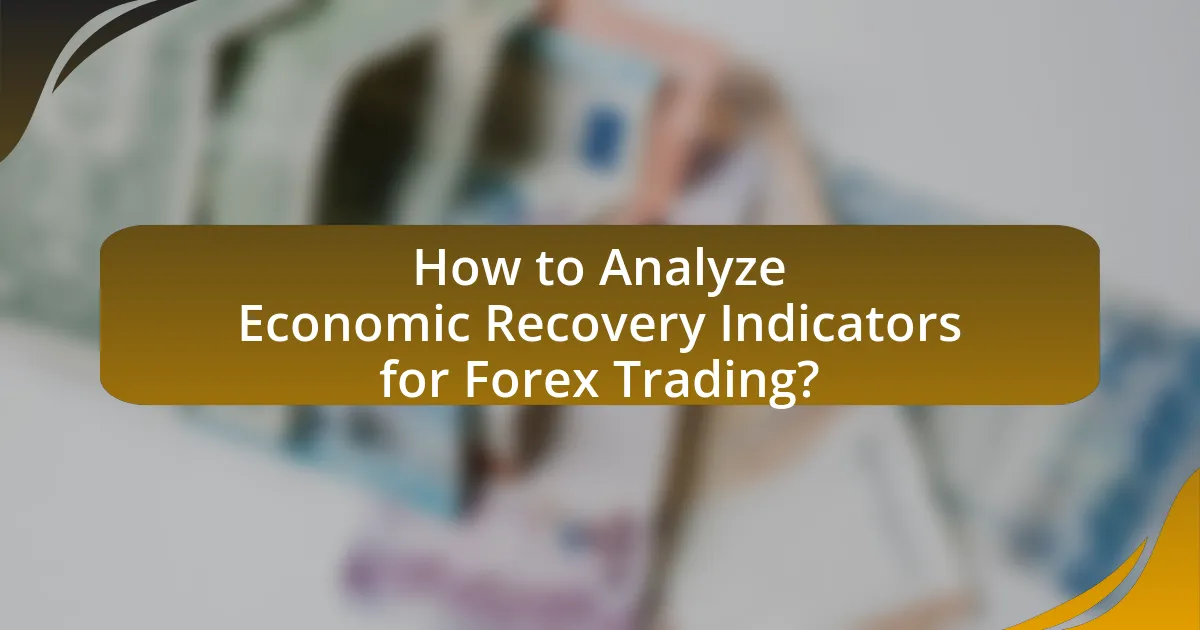
How to Analyze Economic Recovery Indicators for Forex Trading?
To analyze economic recovery indicators for Forex trading, traders should focus on key metrics such as GDP growth rates, unemployment rates, consumer confidence indices, and inflation rates. These indicators provide insights into the overall health of an economy and its potential for recovery. For instance, a rising GDP indicates economic expansion, which can lead to currency appreciation. Historical data shows that during the recovery phase post-2008 financial crisis, countries with strong GDP growth, like the United States, saw their currencies strengthen against others. Additionally, a declining unemployment rate typically signals a recovering labor market, which can boost consumer spending and further support currency value. Monitoring these indicators allows traders to make informed decisions based on economic trends and potential currency movements.
What analytical methods can traders use to interpret these indicators?
Traders can use technical analysis, fundamental analysis, and sentiment analysis to interpret economic recovery indicators. Technical analysis involves examining historical price movements and patterns to forecast future price behavior, often utilizing indicators such as moving averages and relative strength index (RSI). Fundamental analysis focuses on economic data, such as GDP growth rates and unemployment figures, to assess the overall health of an economy and its potential impact on currency values. Sentiment analysis gauges market sentiment through news, reports, and trader positioning, helping traders understand the prevailing mood in the market. These methods collectively enable traders to make informed decisions based on economic recovery indicators, enhancing their trading strategies.
How can technical analysis complement economic indicator analysis?
Technical analysis can complement economic indicator analysis by providing insights into market sentiment and price trends that economic data alone may not reveal. While economic indicators, such as GDP growth or unemployment rates, offer a macroeconomic view of market conditions, technical analysis focuses on historical price movements and trading volumes to identify patterns and potential future price actions. For instance, during periods of economic recovery, technical analysis can help traders identify entry and exit points based on price levels and momentum indicators, enhancing decision-making. This dual approach allows traders to align their strategies with both fundamental economic conditions and market psychology, leading to more informed trading decisions.
What role does fundamental analysis play in understanding these indicators?
Fundamental analysis plays a crucial role in understanding economic recovery indicators by providing insights into the underlying economic conditions that drive these indicators. This analysis involves evaluating economic data, such as GDP growth rates, unemployment figures, and inflation rates, to assess the overall health of an economy. For instance, a rising GDP typically signals economic expansion, which can lead to increased currency value, while high unemployment may indicate economic distress, affecting currency strength negatively. By interpreting these indicators through fundamental analysis, traders can make informed decisions about currency movements in the Forex market, aligning their strategies with economic realities.
What are the best practices for incorporating Economic Recovery Indicators into trading strategies?
The best practices for incorporating Economic Recovery Indicators into trading strategies include analyzing key indicators such as GDP growth rates, unemployment rates, and consumer confidence indices to gauge economic health. Traders should integrate these indicators into their technical analysis to identify potential market trends and reversals. For instance, a rising GDP growth rate often correlates with bullish market sentiment, while a declining unemployment rate can signal economic stability, prompting traders to consider long positions. Historical data supports this approach; during the recovery phase post-2008 financial crisis, positive shifts in these indicators led to significant currency appreciation in several economies. By systematically applying these indicators, traders can enhance their decision-making processes and improve their trading outcomes.
How can traders develop a systematic approach to using these indicators?
Traders can develop a systematic approach to using economic recovery indicators by establishing a clear framework that includes defining specific indicators, setting entry and exit criteria, and backtesting strategies. This framework allows traders to consistently analyze data such as GDP growth rates, unemployment figures, and consumer confidence indices, which are critical for understanding economic recovery trends.
For instance, a trader might decide to use GDP growth as a primary indicator, entering trades when growth exceeds a certain threshold and exiting when it falls below another predefined level. Backtesting this strategy against historical data can validate its effectiveness, providing concrete evidence of its potential success in real market conditions. By adhering to this systematic approach, traders can minimize emotional decision-making and enhance their trading performance.
What common pitfalls should traders avoid when analyzing these indicators?
Traders should avoid over-reliance on a single economic recovery indicator when analyzing market conditions. Focusing solely on one indicator can lead to misinterpretation of market signals, as economic recovery is multifaceted and influenced by various factors. For instance, if a trader only considers GDP growth without factoring in unemployment rates or inflation, they may miss critical insights that could affect currency movements. Additionally, traders should be cautious of confirmation bias, where they only seek information that supports their existing beliefs about market trends, potentially leading to poor decision-making. Historical data shows that traders who diversify their analysis across multiple indicators tend to make more informed decisions, as they capture a broader view of economic health.
What practical tips can enhance Forex trading based on Economic Recovery Indicators?
To enhance Forex trading based on Economic Recovery Indicators, traders should closely monitor key economic data releases such as GDP growth rates, unemployment figures, and consumer confidence indices. These indicators provide insights into the health of an economy, which directly influences currency strength. For instance, a rising GDP typically signals economic expansion, leading to a stronger currency, while increasing unemployment may indicate economic distress, weakening the currency. Historical data shows that currencies of countries with robust economic recovery outperform those with stagnant or declining economies. Therefore, integrating these indicators into trading strategies can improve decision-making and increase the likelihood of profitable trades.



